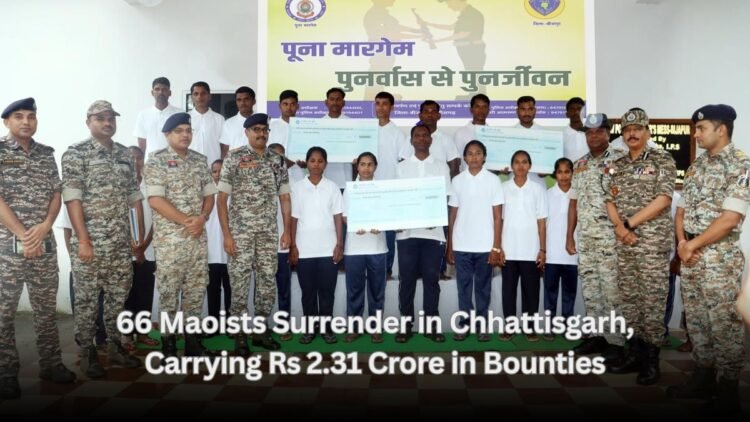Historic Surrender Signals Shift Toward Peace and Development in Bastar
RAIPUR (India CSR): In a landmark victory for peace and reconciliation, 66 Maoists, including high-ranking cadres with a collective bounty of Rs 2.31 crore, laid down their arms in Chhattisgarh’s Bastar division on July 24, 2025. This mass surrender, one of the largest in recent years, reflects the growing impact of the state’s rehabilitation programs and offers hope to communities long affected by conflict, as they look toward a future of stability and progress.
A Wave of Surrenders Across Bastar
The surrender of 66 Maoists, including 49 top cadres and four women, took place across five districts in the Bastar division—Bijapur, Dantewada, Kanker, Sukma, and Narayanpur. Leading the group was Ramanna Irpa, a 37-year-old state zonal committee member (SZCM) from Bijapur, carrying a Rs 25 lakh bounty. Ramanna, who surrendered with 24 others in Bijapur alone, was a key figure in Maoist operations, overseeing jungle warfare training and orchestrating attacks across Chhattisgarh and Odisha. The group’s total bounty of Rs 1.15 crore in Bijapur underscores the significance of this event in weakening insurgent networks.
Disillusionment with Maoist Ideology
Ramanna, once a central figure in the Maoist movement since 2002, expressed disillusionment with the group’s unfulfilled promises. “I joined inspired by the ‘Jal-Jungle-Jameen’ campaign, but after 25 years, I saw no development or progress,” he told reporters in Bijapur. His sentiments echo a growing trend, with 1,570 Maoists surrendering in Chhattisgarh over the past 18 months. The state’s ‘Poona Margham’ campaign, focused on rehabilitation and social integration, has played a pivotal role in encouraging cadres to abandon violence and reintegrate into society.
Key Figures in the Surrender
In Dantewada, 15 Maoists, including five with a combined bounty of Rs 17 lakh, surrendered. Among them were Budhram (alias Lalu), a divisional committee member with an Rs 8 lakh bounty, and his wife Kamli (alias Moti Potavi), an area committee member with a Rs 5 lakh bounty. The couple, active for over two decades, cited the futility of the Maoist cause as their reason for surrender. In Kanker, 13 Maoists, led by Manglu (alias Rupesh), a military commander with a Rs 10 lakh bounty, also renounced violence. Manglu was implicated in multiple deadly ambushes between 2006 and 2024, making his surrender a significant blow to Maoist operations.
Government’s Rehabilitation Efforts Shine
Chhattisgarh Chief Minister Vishnu Deo Sai hailed the surrenders as a testament to the state’s welfare-oriented policies. “This is not a coincidence but a result of our surrender and rehabilitation initiatives,” he said. Programs like the Niyad Nellanar Yojana have built trust in tribal-dominated regions by providing education, healthcare, and livelihood opportunities. The government’s focus on development, coupled with security operations, has created an environment where former insurgents see a viable path to a better life.
A Step Toward Lasting Peace
The mass surrender marks a turning point in Chhattisgarh’s decades-long battle against Maoist insurgency. By targeting high-profile cadres and offering rehabilitation, the state is dismantling the operational backbone of the movement while addressing the root causes of unrest. The surrendered Maoists will receive support for reintegration, including vocational training and financial assistance, as part of the government’s commitment to sustainable peace. This development not only weakens the insurgency but also paves the way for infrastructure and economic growth in Bastar.
Broader Implications for the Region
The surrenders come at a time when Chhattisgarh is intensifying efforts to transform the Bastar division through development projects, such as the proposed Raipur-Durg Metro Rail and industrial investments. By reducing Maoist influence, the state is creating a safer environment for economic progress, benefiting tribal communities and fostering regional stability. As more cadres choose peace over conflict, Chhattisgarh’s vision of a prosperous and inclusive future is coming closer to reality.
(India CSR)







